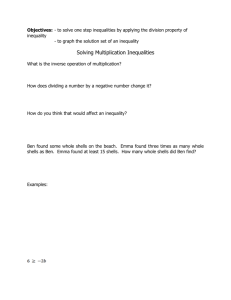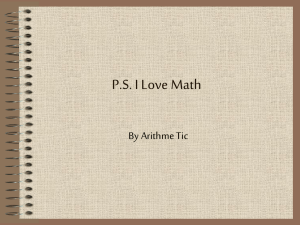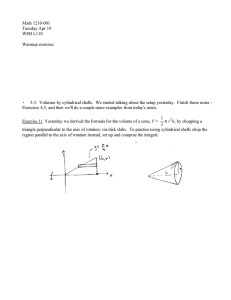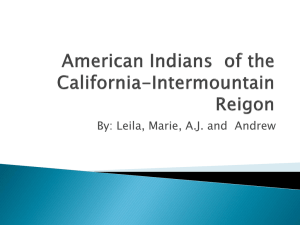Influence of natural reflective mulch on Pinot noir Background
advertisement
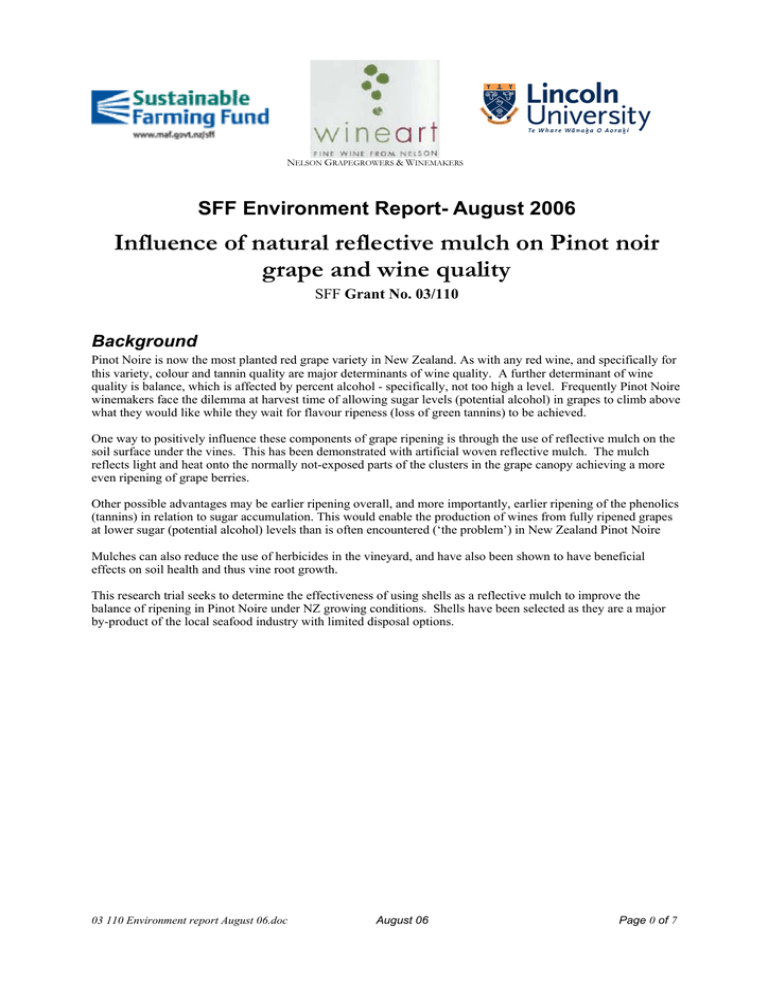
NELSON GRAPEGROWERS & WINEMAKERS SFF Environment Report- August 2006 Influence of natural reflective mulch on Pinot noir grape and wine quality SFF Grant No. 03/110 Background Pinot Noire is now the most planted red grape variety in New Zealand. As with any red wine, and specifically for this variety, colour and tannin quality are major determinants of wine quality. A further determinant of wine quality is balance, which is affected by percent alcohol - specifically, not too high a level. Frequently Pinot Noire winemakers face the dilemma at harvest time of allowing sugar levels (potential alcohol) in grapes to climb above what they would like while they wait for flavour ripeness (loss of green tannins) to be achieved. One way to positively influence these components of grape ripening is through the use of reflective mulch on the soil surface under the vines. This has been demonstrated with artificial woven reflective mulch. The mulch reflects light and heat onto the normally not-exposed parts of the clusters in the grape canopy achieving a more even ripening of grape berries. Other possible advantages may be earlier ripening overall, and more importantly, earlier ripening of the phenolics (tannins) in relation to sugar accumulation. This would enable the production of wines from fully ripened grapes at lower sugar (potential alcohol) levels than is often encountered (‘the problem’) in New Zealand Pinot Noire Mulches can also reduce the use of herbicides in the vineyard, and have also been shown to have beneficial effects on soil health and thus vine root growth. This research trial seeks to determine the effectiveness of using shells as a reflective mulch to improve the balance of ripening in Pinot Noire under NZ growing conditions. Shells have been selected as they are a major by-product of the local seafood industry with limited disposal options. 03 110 Environment report August 06.doc August 06 Page 0 of 7 Environment Report This report is a summary of environmental data collected over the 2005-2006 season in the trial area. Included are results from environmental measurements (temperature and UV data), and the results of analytical work performed on fresh grape samples collected at harvest. Canopy Temperature Measurements The Shell treatment had a significant effect on fruiting zone temperatures in the 2005-2006 season. However, unlike the season before, the shells in this case resulted in a slight decrease compared to the control: on average approximately -0.2°C over the entire season. This is possibly due to the 2005-2006 season being somewhat warmer than last season, resulting in less impact of shells on influencing temperature (e.g. given that the amount of light was similar, having a higher ambient temperature is more likely to mask a treatment difference). This will need to be examined further in the coming season. The figure below shows the canopy temperature in the Control treatment (blue line) through the 05-06 season (harvest for the microvinifications took place on March 14). The red line is the difference (Shells value minus the Control value) of temperature between the treatments through the season. Noting the position of zero on the right y-axis, you can see that for most of the days the fruiting zone was cooler in the Shells treatment than the Control - up to 0.6°C cooler in some instances. The fruiting zone temperature tended to be slightly warmer in the Shells treatment at the beginning of the season and also for a period in December (approx. 13th 21st). Further information about the daily weather in the area would be needed to try to answer the question why this was so. The temperature difference is slight, but consistent, which could have had an effect on grape composition. 2005-2006 Season Control Shells-Control 0.8 -0.4 3 -0.6 0 -0.8 August 06 /M 14 /M 02 18 /F e b b /F e 06 /Ja 25 /01 13 /12 31 /12 18 /12 05 /11 22 /11 09 /10 27 /10 14 /10 01 03 110 Environment report August 06.doc ar 6 ar -0.2 n 9 /06 0.0 /05 12 /05 0.2 /05 15 /05 0.4 /05 18 /05 0.6 /05 21 /05 Temperature 24 Page 2 of 7 The next figure shows the average hourly temperature in the Control treatment (blue line) for the bulk of the ripening period only. The red line again indicates the difference of Shells value minus the Control value for this time period. Note that zero for the difference is again in the middle of the right-hand y-axis. We see that the fruit over the Shells are in a slightly cooler environment in the morning, but by shortly after solar noon, they end up being warmer than the fruit in the Control areas until the after sun goes down (about 9pm). This results in the fruit in the Shells treatment experiencing a slightly more continental climate, as their lows are lower and their high temperatures are sometimes higher. The net difference in terms of average is minimal. 23Jan through 14Mar 2006 26 1.4 24 Control Shells-Control 22 1.0 Temperature (degC) 20 0.6 18 16 0.2 14 12 -0.2 10 8 -0.6 6 4 -1.0 2 -1.4 23:2 1 22:2 1 21:2 1 20:2 1 19:2 1 18:2 1 17:2 1 16:2 1 15:2 1 14:2 1 13:2 1 12:2 1 11:2 1 10:2 1 09:2 1 08:2 1 07:2 1 06:2 1 05:2 1 04:2 1 03:2 1 02:2 1 01:2 1 00:2 1 0 Overall, we can see that there was a slightly different response to the treatments for fruiting zone temperature in this past season. However, it seems from preliminary tastings of the wines, that despite this, aroma and flavour trends have remained the same. Soil Temperature Measurements The mussel shells continue to decrease soil temperature as measured at 10cm depth. The figure below shows the effect over the average 24 hours of a day between September 2005 and May 2006 in the form of temperature in the Control block minus the Shell block's soil temperature. Soil in the Shells treatment is warmer than in the Control from about 2am to 8:30am, but for the rest of the day is cooler - by up to 4°C in mid-afternoon. The shells have an insulating effect on the soil, preventing as much solar energy being stored during the day, but also preventing some loss of heat during the night. Any impact from the production point of view is most likely minimal, as these differences are not great enough, nor affecting enough of the root-soil volume of the vines, to change productivity significantly. 03 110 Environment report August 06.doc August 06 Page 3 of 7 2005-2006 Soil Temperature Difference Control - Shells (degC) 4 3 2 1 0 23 :28 :00 21 :48 :00 20 :08 :00 18 :28 :00 16 :48 :00 15 :08 :00 13 :28 :00 11 :48 :00 10 :08 :00 08 :28 :00 06 :48 :00 05 :08 :00 03 :28 :00 01 :48 :00 00 :08 :00 -1 In looking at the data separated into two segments, 2005 and 2006, the two figures below show the difference of Control minus Shells soil temperatures for the periods of September 20 through December 31 2005 and January 1 through April 13 2006, respectively. Soil Temperature Differences 4.5 Control minus Shells (degC) 4 3.5 3 2.5 2 1.5 1 0.5 0 03 110 Environment report August 06.doc August 06 25 /12 /05 17 /12 /05 09 /12 /05 01 /12 /05 23 /11 /05 15 /11 /05 07 /11 /05 30 /10 /05 22 /10 /05 14 /10 /05 06 /10 /05 28 /09 /05 20 /09 /05 -0.5 Page 4 of 7 Soil Temperature Differences 4.5 Control minus Shells (degC) 4 3.5 3 2.5 2 1.5 1 0.5 0 08 /04 /06 31 /03 /06 23 /03 /06 15 /03 /06 07 /03 /06 27 /02 /06 19 /02 /06 11 /02 /06 03 /02 /06 26 /01 /06 18 /01 /06 10 /01 /06 02 /01 /06 -0.5 These show that the Control soil temperature was consistently warmer than the soil in the Shells treatment through all but the very last of the season. The biggest differences between soil temperatures occurred in December, and gradually decreased as the season progressed. These are similar trends as reported in the previous season (Crawford, 2006). Mulch Reflectance The Shell mulch continued to have a positive effect on the amount of reflected UV radiation in the canopy. The figure below shows that under overcast or sunny conditions there is a significant increase in reflected UVA and UVB radiation: about 8% in sunny conditions and 12% in overcast conditions. These results emphasise the different light environment that the Shell treatment fruit is in, and that shells may have their most significant effect on cloudy days, as more UV radiation (and light) reflected into the canopy can increase photosynthesis and other physiological processes. While there are noticeable visual differences in the amount of reflected light in the treatments, measurement of photosynthetically-active radiation (PAR) was attempted to try to quantify this difference. However, difficulties with the sensor were encountered, so this will be attempted again in the next season. 03 110 Environment report August 06.doc August 06 Page 5 of 7 Percentage Reflection (W/m2) 20% 18% UVA UVB1 16% UVB2 14% 12% 10% 8% 6% 4% 2% 0% Control-Overcast Shells-Overcast Control-Sunny Shells-Sunny Berry Variability Measurements Clusters were taken at harvest and stored at -20°C until processing. Ten clusters each from the treatment areas were analysed on a cluster by cluster basis. These results were presented in the 06June Quarterly Report. To obtain more information about the effects of the treatments on within-cluster variability, berries from individual clusters taken from each treatment area were separated from the rachis, the rachis weighed, and then these data taken for each berry: weight, brix and phenolic extraction of skin discs. In addition, a population of 90 berries had juice malic acid measured (by RQflex). Data were also taken on cluster peduncle colouring, rachis weight and cluster wing weight (if present). Berries in the wings of clusters were not included in these data, though that have been saved for potential further analyses. Due to the time-consuming nature of the processing, at the time of preparing this report data for approximately 675 berries was available, with analysis of about two-thirds of the samples complete. Presented here are the preliminary results from data available (berry malate expressed in RQFlex units). Berry Malate Treatment Control Shells Sample Size 40 50 Berry Brix Berry Wt Control Shells Control Shells 279 386 302 400 A520/disc Control Shells 279 386 0.046 A280/disc Control Shells 279 386 Mean 29.6 38.9 25.1 24.4 0.90 1.05 0.048 Variance Std error of mean Std error for diff. of means: Probability 123 106 11.3 5.6 0.15 0.16 0.0001 0.0001 0.0003 0.0003 1.75 1.46 0.20 0.12 0.02 0.02 0.001 0.001 0.059 0.001 0.053 0.001 2.26 0.23 0.03 0.0009 0.0012 < 0.001 0.01 < 0.001 0.03 < 0.001 From these data we see that there are significant differences between the treatments in all categories (note that probability values in the final row are all less than 0.05). However, contrary to what we might have expected, malate concentration appears to be higher in the berries from the Shell treatment, even taking into consideration the slightly lower Brix levels in berries over the shells. This may be due to the slightly lower temperatures in the Shells treatment fruiting zone, or the changed light environment in the Shells treatment resulting in 03 110 Environment report August 06.doc August 06 Page 6 of 7 greater production of malic acid early in the season. More detailed measurements of berry composition during the entire berry development period would be necessary to determine if this was so. It is likely that there is an interaction between seasonal environment, berry malate and berry tartrate, which would make figuring out their relationship difficult. In this season also, berry weight was 15mg higher in the Shells compared to the Control treatments, which may have contributed to the slightly lower absorbance at 520nm (indicating the concentration of anthocyanins in the skin discs) and 280nm (indicating the overall concentration of phenolics in the skin discs). These data are somewhat at odds with the data collected from the microvinification must measurements (see Quarterly Report for June 2006), which indicated that the Control must had slightly lower Brix than the Shell (23.6 vs. 23.9), but are very close to the frozen cluster analysis (also presented in the June 2006 Quarterly Report), which reported 24 and 23.9 for the Control and Shells berry Brix, respectively (though this difference was not significant, statistically speaking). It should be noted that Brix reported in the table above was measured from a drop of expressed juice while those reported for the frozen clusters and microvinification must were from crushed grapes. Because of the size of the dataset involved in making the table above, we have great resolution in terms of being able to say one average is statistically different from another, but in a practical sense, there is no discernible difference between anthocyanins in wines from each treatment. However, in looking at the Variance of each of the parameters in the above table, we can see that for Berry Malate, Berry Brix and Berry Wt the value is less for Shells than it is for Control. This is an indication that there are fewer low-value berries and fewer high-value berries in each of the measurements. Therefore, the Shells treatment has been successful in reducing the amount of variability within clusters: a fact that will be further investigated during the course of the project. Reference Crawford, M. 2006. Influence of Reflective Mulch on Pinot noir Grape and Wine Quality. MApplSc thesis. Lincoln University. In Examination. 03 110 Environment report August 06.doc August 06 Page 7 of 7


